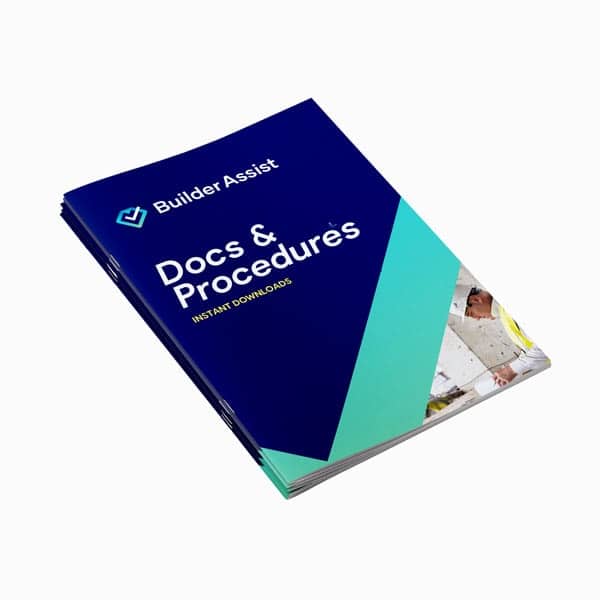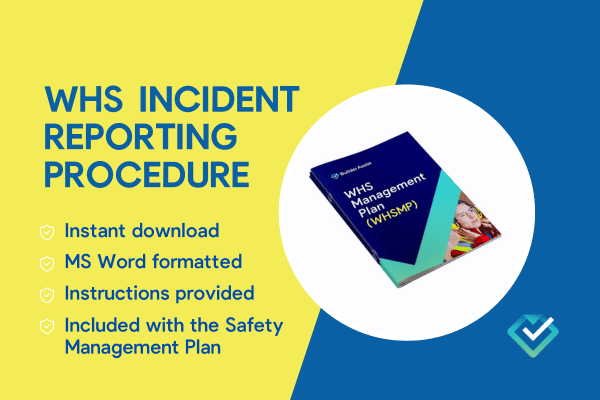
An accurate WHS incident reporting procedure on construction sites is paramount to a safety-first ethos.
It empowers immediate responses, drives continuous improvement, promotes safe work sites, ensures compliance, and contributes to the overall success and reputation of construction businesses.
If you're in the process of preparing your business for site safety compliance and need a WHS incident reporting procedure template, they’re included as part of the Builder Assist Safety Management Plans. To download one instantly, visit our Safety Management Plans page to find a trade-specific template.
By integrating incident reporting into a Safety Management Plan, businesses proactively manage incidents, enhance transparency, and drive continuous improvement in safety practices.
This approach aligns with a holistic commitment to safeguarding personnel, maintaining project integrity, and upholding industry standards.
Correct WHS Incident Reporting Procedure
Documenting a construction Workplace Health and Safety (WHS) incident is a crucial step in ensuring that all relevant details are accurately recorded for future reference, investigation, and reporting purposes.
The correct WHS incident reporting procedure can vary depending on the State you operate in, the specific regulations in place, and the nature of the incident.
However, here's a general outline of the steps you might follow for construction WHS incident reporting procedure:
Secure the Scene
Before documenting anything, ensure the safety of all personnel and secure the incident scene to prevent further harm or damage.
Provide Medical Assistance
If there are injuries, seek medical assistance for the affected individuals immediately. Their well-being is of paramount importance.
Collect Information
Gather as much information as possible about the incident. This includes:
- Date, time, and location of the incident
- Names and contact information of all individuals involved
- Names and contact information of witnesses
- Description of what happened and how the incident occurred
- Type of incident (e.g., fall, equipment malfunction, hazardous material exposure)
- Any equipment, tools, or materials involved
- Environmental conditions (e.g., weather, lighting)
- Immediate actions taken after the incident
- Any visible injuries or damages
Take Photographs
If applicable, take photographs of the incident scene, equipment, tools, or any other relevant factors. Visual documentation can provide valuable context during investigations.
Interview Witnesses
If there were witnesses to the incident, interview them to gather their perspectives on what happened. Document their statements and contact information.
Involve Health and Safety Representatives
If you have health and safety representatives or committees, involve them in the documentation process. Their insights can contribute to a comprehensive understanding of the incident.
Use Incident Report Forms
Many workplaces have incident report forms or templates specifically designed to capture essential details. Fill out these forms accurately and thoroughly. If not, create your own document with the required information.
Describe the Injuries or Damages
Clearly describe any injuries sustained by individuals involved in the incident. If there are damages to equipment, tools, or property, note them as well.
Include Pre-Existing Conditions
If any individuals involved had pre-existing medical conditions that could have been aggravated by the incident, include this information.
Outline Immediate Actions Taken
Document the immediate actions taken after the incident to secure the scene, provide medical assistance, and prevent further harm.
File and Store Documentation
Keep the incident documentation in a secure location where it can be easily accessed if needed. Ensure it's organised and properly labelled.
Reporting
Based on your jurisdiction's regulations and internal procedures, report the incident to the relevant authorities, if required.
Notifiable Incidents
It’s important to note that if the incident is severe, for example, if the outcome results in serious injury, illness, or if there is a dangerous incident at work, then relevant authorities must be notified. These are called ‘notifiable incidents’. It is the law to report these types of incidents and they encompass:
- The fatality of an individual.
- A 'serious injury or illness.'
- A 'dangerous incident' that exposes someone to a significant risk, irrespective of whether injuries occur.
These 'notifiable incidents' can involve any individual, including employees, contractors, or members of the public.
Vital Role of an Accurate WHS Incident Reporting Procedure on Construction Sites
Accurate and timely Workplace Health and Safety (WHS) incident reporting procedures are extremely important to ensure the safety and well-being of workers, mitigating risks, and maintaining the integrity of construction sites.
This cannot be overstated, because they have far-reaching implications that resonate throughout the industry.
Promoting Immediate Responses
Prompt reporting of WHS incidents empowers site managers and supervisors to take immediate action to address injuries, prevent further harm, and secure the incident scene. This rapid response can make a substantial difference in minimising the impact of incidents.
Preventing Recurrence
Accurate incident reporting facilitates thorough investigations into the root causes of incidents. Identifying these causes enables construction teams to implement targeted corrective measures that address the underlying issues, effectively preventing similar incidents in the future.
Promoting Safe Job Sites
Robust incident reporting procedures foster a safety ethos where workers are encouraged to report hazards, near misses, and incidents without fear of repercussions. This open communication leads to heightened hazard awareness, improved risk assessment, and proactive safety measures.
Compliance and Legal Obligations
Correct incident reporting ensures compliance with regulatory authorities and legal obligations. Some States and Territories mandate the reporting of specific types of incidents, and adhering to these requirements avoids potential fines and penalties.
Data-Driven Decision Making
Accumulated incident data serves as a valuable resource for making informed decisions. By analysing trends and patterns in incident reports, construction companies can identify areas that require targeted interventions, allocate resources more effectively, and continuously improve safety protocols.
Reputation Management
Maintaining a strong safety record through accurate incident reporting contributes to a positive reputation within the industry. Clients, partners, and stakeholders are more likely to engage with construction companies that prioritise safety and demonstrate proactive incident management.
Worker Trust and Morale
When workers observe that their safety concerns are taken seriously and that incidents are promptly addressed, their trust in the organisation's commitment to their well-being grows. This, in turn, boosts morale and job satisfaction.
Financial Considerations
Incidents can have financial implications, from increased insurance costs to medical expenses and legal proceedings. Proper incident reporting enables better management of these financial repercussions.
By meticulously documenting a construction WHS incident, you create a factual record that can aid in investigations, insurance claims, and preventive measures.
Clear and comprehensive documentation serves as a crucial foundation for improving workplace safety and preventing future incidents.
An accurately completed WHS incident reporting procedure drives continuous improvement, enhances safety culture, ensures compliance, and contributes to a business’s overall reputation and success.
Other useful incident reporting documentation includes:

Safety Management Plans (WHS)
Specifically designed for each trade starting up a business, these Work Health Safety Management Plans or WHS Management Plans, provide support with the management of Work Health & Safety in the workplace. Also referred to as Occupational Health & Safety (OH&S) the material provided in this section will assist with WHS/OHS management and training requirements for the workplace.



